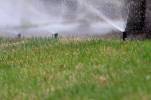Dish soap helps eliminate unwanted insects
Q: Unknown insects are starting to eat the foliage of my Italian basil. What can I do? Before I start to spray something appropriate I would like to know from you what is the best and safest to use.
A: The round, circular holes cut in the leaves appears to be from leafcutter bees. This will be a problem as they are good pollinators and should not be killed.
It might be best to net the basil to keep the bees from damaging the leaves and using it for nesting. Good trap plants for leafcutter bees (plants that they might focus on rather than your basil) include roses, grapes, bougainvillea and other plants with smooth, thin leaves.
For insects that damage leafy vegetables and herbs I use soap and water sprays (insecticidal soaps) every three days. I use a pressurized sprayer and spray the tops of the plants and then, with the nozzle pointed upward, spray the undersides of the leaves as well. I try to do this as early in the morning as possible.
You can use a pure Ivory liquid detergent at a rate of about one tablespoon of detergent per gallon of water. Add the detergent after you fill the sprayer so it does not foam. Mix it thoroughly.
The key is regular applications about three times a week and getting complete coverage. The soap and water mixture is lethal to most insects but must come in contact with the insect to be effective.
Soap and water sprays have little residual power, so leaving a residue on the plants is not that all effective. The soap and water spray actually drowns the insects by reducing the surface tension of the water allowing it to enter the insects' breathing systems, thus suffocating them. Untreated water has surface tension that prevents it from entering the breathing passageways. I have heard a very complex claim that it somehow dehydrates them. I understand the reasoning but do not know if this is actually true.
Commercial insecticidal soaps that are good include Dr. Bonners, Ortho's and Safer's. There are probably others as well.
Very few plants in the vegetable garden are harmed by insecticidal soaps but spray at times during the day when temperatures are below 90 F as a precaution. Spraying regularly should minimize damage to basil foliage while controlling insects .
Q: My fruitless olive tree is losing leaves from branches on the south side of the tree. It has been in the ground since December 2010, having been planted from a 36-inch box. I have been watering it three times a week for 20 minutes each time since March, and less frequently during the winter. It has four emitters. Since I noticed the bare branches, I have started to handwater once a week for an hour with a bubbler. The wind usually blows through the tree from the south where the bare branches are located.
A: Let's assume your drip emitters are 3 gallons per hour, a very common rate for drip emitters that are not adjustable. You have four of them. That makes 12 gallons per hour. You water for 20 minutes, which means you water the olive with 4 gallons.
To fill a 36-inch boxed tree with soil I would guess would take about 25 to 30 gallons or more. This tree is way underwatered. Run the hose on the tree in a 4-inch-deep basin surrounding the planting hole and fill the basin twice every time you water. This tree will require somewhere around 30 gallons or more each time you water.
As it is presently configured, you will need to add emitters to the tree or run the drip for at least two to three hours each time you water. Right now you should be watering twice a week with that volume.
I want to add that if you are planting trees and shrubs, you should always handwater them for two to three weeks after planting and then begin your drip system. Do not just turn them over to drip irrigation after planting.
Q: You had mentioned watering oleander every three days during summer months. How many gallons of water per plant is necessary at each watering?
A: It depends on the size of the plant. Small ones get maybe 5 gallons; larger ones get about 15 to 20. They tend to get open and not very dense if they are not getting enough water. If they are getting plenty, then they are full and you can't see through them.
Try to picture what size container might be needed if it were at a nursery or growing in a container. Try to estimate the gallons of that container and then apply at least half of that amount. That is usually how I try to visualize it. You can see quite easily how the size of the plant will determine the amount of water to apply.
Bob Morris is an associate professor with the University of Nevada Cooperative Extension. Direct gardening questions to the master gardener hot line at 257-5555 or contact Morris by email at morrisr@unce.unr.edu.























